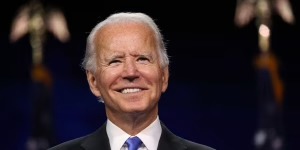History Club’s Opposing Viewpoints: Biden 2020
March 28, 2019
Who Is Bernie Sanders?
A 3-term Independent senator from Vermont, Bernie Sanders is famous for being a prominent Democratic socialist voice in American politics. Sanders was born and raised in Brooklyn, New York, a son of Jewish immigrant parents. He originally studied at Brooklyn College and then transferred to the University of Chicago, where he was an active member and leader of many civil rights groups on campus. Sanders eventually served as mayor of Burlington, Vermont from 1981 until 1989 and was Vermont’s representative to the House of Representatives from 1991 to 2007. He was then elected to the Senate where he continues to serve; he is the longest-serving independent in congressional history.
Sanders is notable for his opposition to the War in Iraq and the Patriot Act, as well as an eight hour filibuster in 2010 on tax cuts. He attempted a presidential run in 2016, where he ultimately lost the Democratic primary to Hillary Clinton; still, he won 23 states and profoundly impacted the leftward trajectory of the Democratic party. As questions arise about the strength of other candidates, especially as many of them endorse his policies, Sanders is certainly already a strong contender for the Democratic nomination.
Bernie’s Popularity Shines
Bernie Sanders, famous for his presidential run in 2016, is already doing well in the early stages of the 2020 Democratic primaries. While there is a lot of time before the Iowa caucuses begin, as well as many good candidates to compete with, Sanders certainly has a strong chance at becoming the Democratic nominee and beating Donald Trump in the general election.
Sanders’ campaign is gaining a lot of support from individual donations and supporters across the country, raising more than four times Kamala Harris’ first-day donation total (the previous record) with $5.9 million dollars. With over 38% of donors using an email not previously registered with the campaign, it is clear that Sanders is expanding beyond his already-strong base of support form 2016.
Unfortunately, Sanders still cannot avoid many of the misconceptions surrounding the 2016 election. Opponents claim he split the Democratic vote, even though he actively campaigned for Hillary Clinton across the country for five months following the end of the primary. In fact, a larger proportion of people who voted for Sanders in the 2016 primary voted for Clinton in the general election than people who voted for Clinton in the 2008 primary and voted for Barack Obama in the general election.
Looking at Sanders’ success within the Democratic party, many of the ideas he championed in 2016 that were considered “too radical” are now mainstream. All major candidates have each endorsed universal healthcare, free public college, a federal jobs guarantee, and the Green New Deal. All but Cory Booker have also refused to take any money from Super PACs—a feat Sanders’ campaign first adopted in 2016. As the first to support many of these ideas, Sanders has become a key figure among a party that is moving more leftward; other candidates are racing to catch up to his long-standing progressive record.
Further, if Sanders is to win the Democratic nomination, he would certainly have a strong chance at beating Trump. One of the most considerable outcomes of most recent presidential election was how many Midwestern states flipped from Democrat to Republican from the 2012 to 2016 elections. Many of Sanders’ positions, such as his support for unions, expanding infrastructure and manufacturing jobs, as well as increasing the federal minimum wage to $15 per hour, would easily gain him support from voters in those areas.
Sanders won the 2016 primaries in Michigan, a state that Obama won by 9.5% in 2012 but went to Trump in 2016. He also won in Wisconsin by 13% and only narrowly lost Iowa by 0.2%. In the conservative and rural West Virginia, where Trump won 67.9% of the vote, Sanders won all 55 counties.
While much remains up in the air about the Democratic primary, Sanders definitely has a clear mandate of support going into 2019—and it certainly isn’t going away anytime soon.
Dems Need A Real Winner
Vermont Senator Bernie Sanders is running for President on a platform of “democratic socialism,” and while this message currently has strong support within the Democratic Party, there are numerous weaknesses that he faces in a general election.
Mr. Sanders has been transformational in his truly alternative vision for America—one in which the collective is valued over the individual and the role of the federal government in citizens’ lives would be dramatically expanded in the realms of healthcare, education, and the means of production. This vision is increasingly popular amongst young liberals, but will face significant opposition from a general public that is still just slightly left of the center on average and highly skeptical of the kind of government expansion that Sanders preaches. Indeed, a wide-ranging NBC and Wall Street Journal poll this month found that only 24% of Americans would feel comfortable with a socialist president—a label Mr. Sanders has eagerly adopted.
To begin with, he faced significant opposition from within his own party, which would depress turnout in a general election. His lifelong political career as an independent and lackluster support for Hillary Clinton in the 2016 election by public undermining of her positions have left many with the view that he directly contributed to Mr. Trump’s victory, harming his reputation with Democratic loyalists. His history of pro-gun rights campaigning in Senatorial campaigns and multiple accusations of sexual harassment by top male aides in his 2016 campaign have also turned off many progressive and feminist organizations, which are key for mobilizing regional support.
Sanders also faces problems when it comes to winning over ethnic minority voters. In the 2016 primaries, he received minimal support from African Americans and Hispanics, and today, the majority of his support in the Democratic Party is made up of urban, middle-class, white voters. While that demographic has been pretty consistent in voting Democrat in recent elections, the African American and Hispanic populations are subject to far more volatility in voter turnout. Additionally, they are absolutely essential to the liberal coalition, especially in states such as Virginia and Florida. Furthermore, Sanders’ refusal to condemn authoritarian socialist regimes in Cuba and Venezuela has angered and alienated exiles from those countries, further endangering support by Hispanic voters. President Trump has consistently polled around 40% to 45% with Hispanic voters, and when faced with a hypothetical election between Trump and Sanders, Hispanics swing Republican.
While many enthusiast voters are banking on Bernie Sanders to restore the White House to Democratic control in 2020, in a straight-up election with Donald Trump, he would walk into the fight with a structurally damaging label, an uncertain party, and uncertain turnout from minority supporters. It is not likely that he can win, and with an election as critical as the one in 2020, nothing can—or should—be left to chance.
This piece also appears in our March 2019 print edition.









